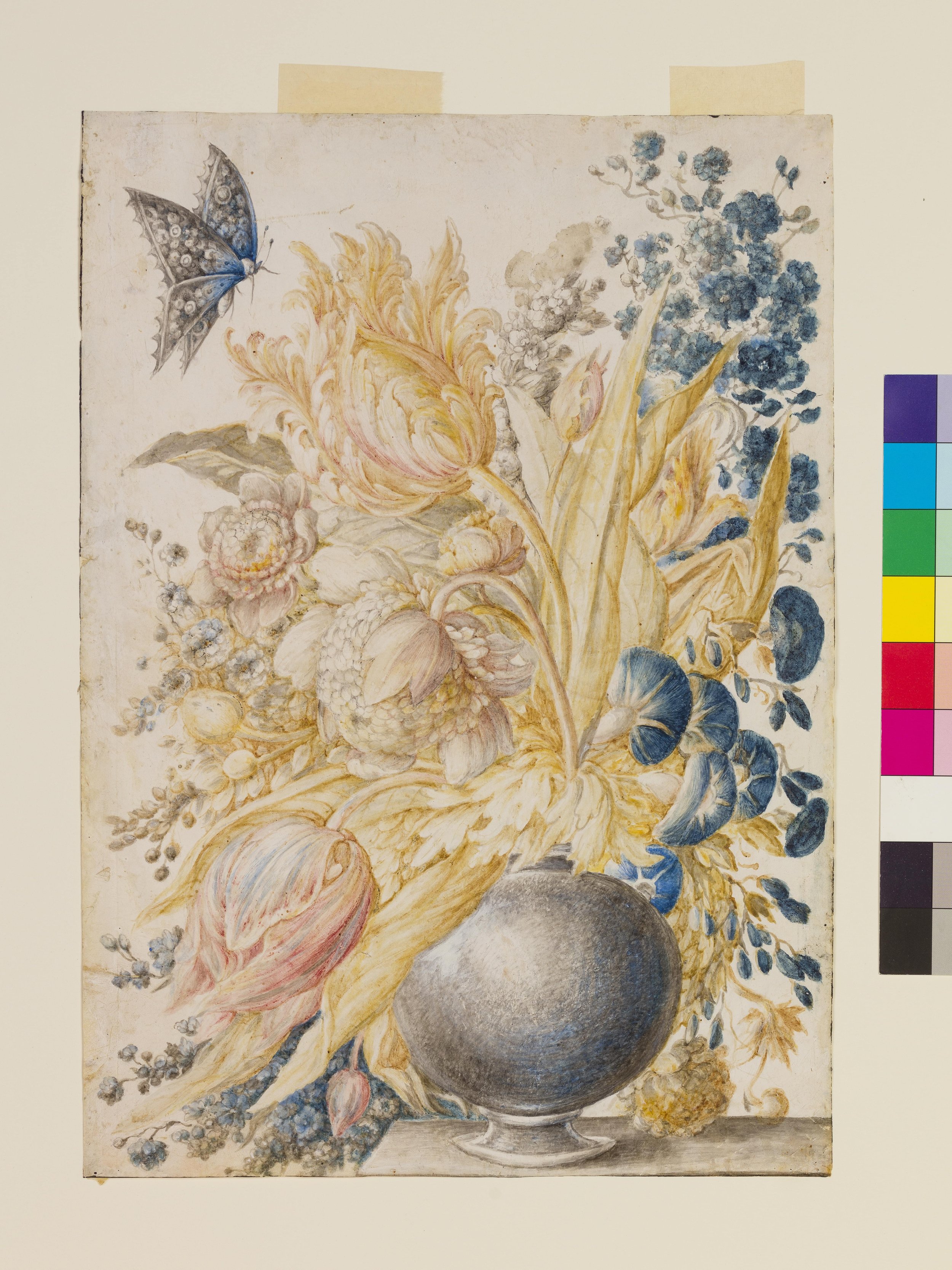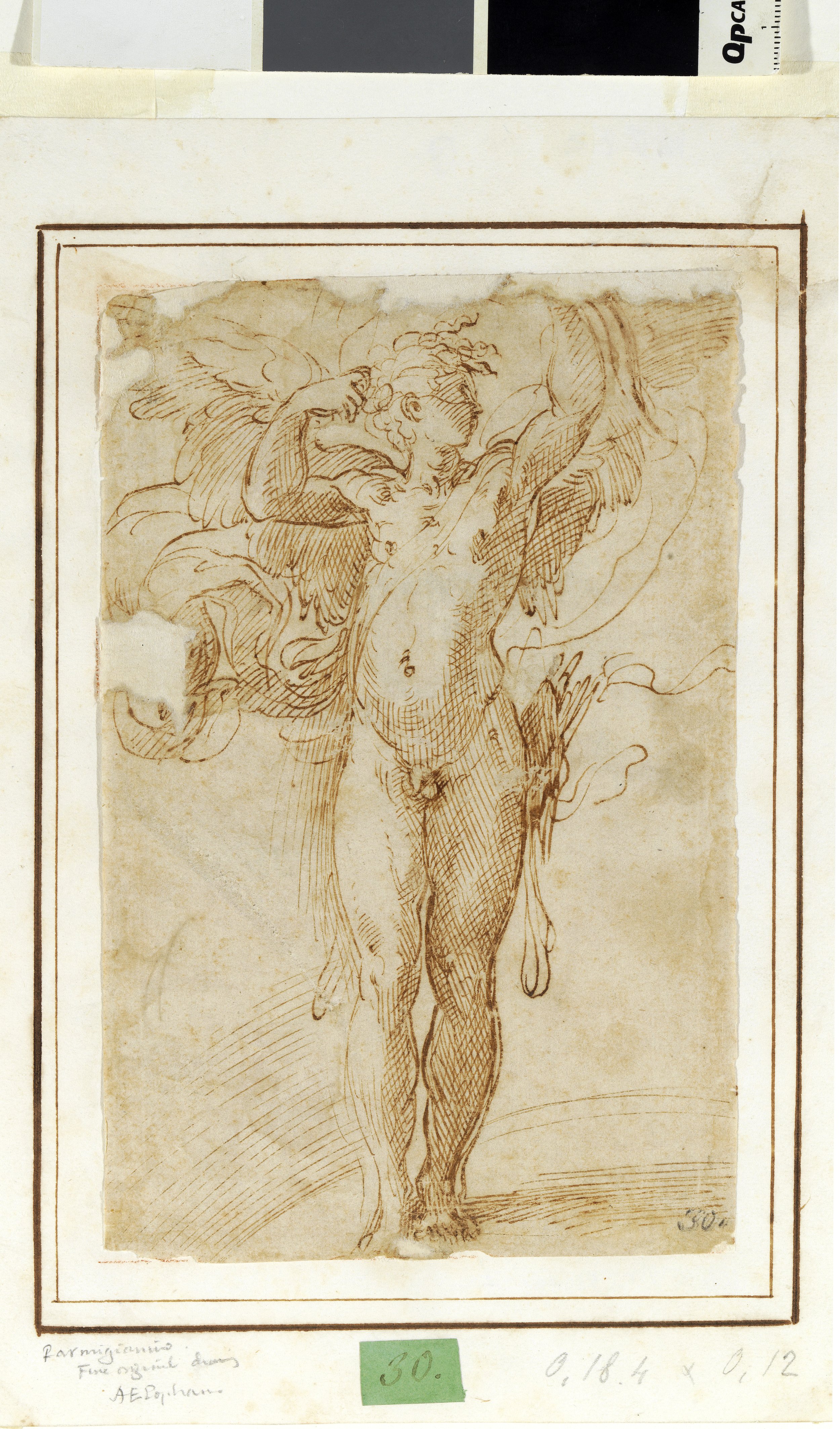Demystifying Drawings #13
Tuesday, 1 October 2024. Newsletter 13.


The Farnese Drawings at Capodimonte
Giovanna Garzoni, Compositon of Flowers and Butterflies, black chalk, tempera, and diluted ink on parchment, 361 x 256 mm, Naples, Museo e Real Bosco di Capodimonte, GDS 822
Francesco Mazzola called il Parmigianino, Cupid drawing his bow (recto), pen and ink on paper, 182 x 132 mm, Naples, Museo e Real Bosco di Capodimonte, GDS 1037
Dr Van Cleave at the Museo e Real Bosco di Capodimonte
The House of Farnese is amongst the most culturally prominent in Italian history, boasting a Pope, countless Dukes and Duchesses, and in its subsequent iteration, the house of Bourbon-Parma, Kings and Queens of Spain and Naples. The Farnese name is woven into the fabric of European culture, with monuments such as the Palazzo Farnese in Rome, antiquities such as the ‘Farnese Hercules’ and the ‘Farnese Atlas’, all prefaced by the family name, and a patronage roster that included Michelangelo, Titian, and the Carracci.
What is less widely recognised is that the Farnese also possessed a substantial collection of drawings. What remains of that collection is now housed at the Museo di Capodimonte, the grand palace that Charles of Bourbon built on a hill above Naples to house the vast collections he was given by his mother, Elisabetta Farnese. Dr Claire Van Cleave has spent the last 4 years compiling a new catalogue of the Farnese drawings at Capodimonte, the first to be published in English. Despite the collection’s prestigious heritage, the drawings have largely remained hidden from both scholars and the public. Our editor speaks with Dr Van Cleave about the project to catalogue the drawings, democratise access and digitise the collection.
Of all the Farnese patrons and collectors, Pope Paul III and his grandson Cardinal Alessandro are perhaps the most renowned, but who were the primary collectors of drawings in the family? Would it be fair to call the drawings collection at Capodimonte a ‘collection of collections’, or is it dominated by a single collector?
The Farnese drawings collection is without doubt a ‘collection of collections’, which is one of the aspects that has made studying it so fascinating. The drawings amassed in the rarified atmosphere of the Palazzo Farnese were not put together by Paul III, his grandsons Cardinals Ranuccio and Alessandro, or their great nephew Cardinal Odoardo, but by learned men who worked for the family and lived in their palace at the end of the sixteenth century. The key players were the major domo Count Ludovico Tedesco, the artist Giulio Clovio, and the librarian and curator Fulvio Orsini. Closely allied to all three of these men was Tommaso de’ Cavalieri, the recipient of some of Michelangelo’s greatest drawings, whom I consider another one of the personalities who influenced the collecting of works on paper within the Farnese palace.
What is the size and scope of the collection today? How does it compare with the collection at its height? What remains of the original holdings, and are there any particular areas of strength?
At its height, the collection of drawings housed in the Palazzo Farnese included over 850 sheets. The largest contributor to this collection was Giulio Clovio, who bequeathed over 400 of his drawings to Cardinal Alessandro in thanks for employing and sheltering him for over forty years. When Clovio died in 1578, his sheets joined ones purchased by Cardinal Alessandro from the heirs of Ludovico Tedesco. At the same time that these two men were collecting drawings, Fulvio Orsini was amassing an impressive, but small collection of works which he displayed in frames on the walls of the library on the top floor of the palace. When he died in 1600, he left his collection of 47 drawings to the family collection.
Today, the Museo e Real Bosco di Capodimonte houses the remnants of the Farnese drawings collection, which sadly number less than 60 sheets. In the course of my research, I have tried to pinpoint the moments when drawings disappeared from the collection. Some of the stories of the vicissitudes of the Palazzo Farnese after the influence of the Farnese cardinals waned read like the libretto of a dramatic opera, however the fate of the 800+ missing drawings is still largely a mystery. Of the 57 sheets now in Naples, some gems remain: four cartoons related to Michelangelo and Raphael, an impressive collection of sheets by Parmigianino including a hitherto undiscovered dry point print, arguably Sofonisba Anguissola’s most famous drawing, two spectacular works now attributed to Giovanna Garzoni, and many more interesting works, often by Emilian artists. One of the aspects which makes this collection so interesting is the unbroken provenance from the sixteenth century to the present day.
What was the state of affairs - in terms of publication history, digital presence, and conservation - when you arrived at Capodimonte? Why has so historically significant a collection remained as understudied and unexplored as that at Capodimonte?
The Farnese drawings collection has been hiding in plain sight from scholars and enthusiasts for too long. Not many drawings enthusiasts realise that a catalogue of the collection was compiled by Rosanna Muzii and published in 1994 at the back of the Emilian paintings catalogue of the Farnese collection at Capodimonte. The collection has never been published in English, nor is it recorded in any online database. The opportunity to present these drawings to a wider, international audience with new insights to attributions and observations on the history of collecting has been a fantastic and rewarding project.
Given the historic lack of public access and scholarly exposure, I imagine that this project was a simultaneously daunting and exciting prospect. What were the major challenges that you faced, and what surprises emerged during the research process?
Rosanna Muzii’s catalogue was comprehensive, but ignored some publications not written in Italian which are pertinent to advancing knowledge of the collection. As in any good cataloguing project, I have evaluated all recent scholarship on each one of the drawings. This was a challenge at some points during Covid when access to libraries was forbidden, but I am forever thankful to the London Library for posting out books, even all three volumes of A.E. Popham’s seminal work on Parmigianino’s drawings, and for the kind help of fellow scholars such as Achim Gnann who willingly sent me his tomes on Parmigianino, David Ekeserdjian, Hugo Chapman, and others who assisted me along the way. I began this project with the intent to catalogue the collection, but as I learned more about the Farnese family and the circumstances in which the drawings were collected, I was compelled to also research the history of the collection. This aspect of the work has expanded my skills from an expert in drawings to an archivist, which I never expected.
If you had to choose one drawing from the collection to take home with you, what would it be and why?
If I could gaze at any of the drawings from the Farnese collection on a daily basis, it would be Parmigianino’s exuberant drawing of Cupid drawing his bow. Not only is the fluid penwork of the verso a delight, but the recto also reveals the artist’s naughtiest side.
What are your ambitions for the project moving forward? Are we to expect an exhibition of Farnese drawings in future, or is there a new project that you have set your eyes on?
One of the most tragic aspects of the demise of the Farnese drawings collection is the dire state of conservation of most of the remaining sheets. Even in 1800 when the drawings were catalogued after Napoleonic troops sacked Capodimonte, many sheets were described as “molto tarlato”, already in a ruinous state. I would love to find a way to exhibit the Capodimonte drawings, both those at Capodimonte and others which can be identified with a Farnese provenance, alongside better preserved examples by the same artists and use the differences in states of preservation as a learning tool to recount the fate of the collection, but any such exhibition might be too cerebral for most public collections to contemplate mounting.
What are the important dates that readers should mark for their diaries?
The culmination of my research is perhaps better suited to a book than an exhibition, and I am delighted that Editori Paparo in Naples will be publishing The Farnese Drawings Collection this autumn. As I answer these questions, the English edition is going to press. The Italian edition will follow shortly afterwards. As an independent scholar, I am thankful to the institutions and foundations who have assisted me in my journey. This began with the American Friends of Capodimonte, which paid for my initial research on the catalogue to make an online database for the museum, and continued with a grant from the Bibliotheca Hertziana – Max Planck Institute for Art History which enabled me to work in Rome on the history of the collection. Publication of my book would not have been possible without generous grants from the Tavolozza Foundation and the Wolfgang Ratjen Foundation. I am working on dates to present the book in London later this autumn and also in New York for MDNY in early February – no doubt, we will also loudly celebrate the publication in Naples.
Claire be talking about the Farnese drawings for Paola’s Studiolo on December 7. Email Paola to find out more about the fall program of talks.

